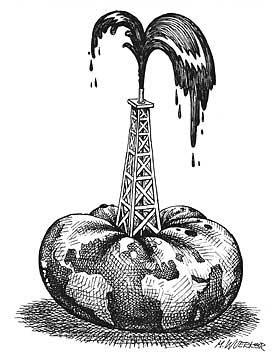OhMyGov ... 'a suppressed' exhaustive 400-page environmental survey of the Great Lakes "areas of concern" because it contained such "alarming information" as evidence of highly elevated infant mortality and cancer rates. According to the study, residents in over 26 danger zones, including major metropolitan centers such as Chicago and Milwaukee, are exposed to elevated health risks resulting from high levels of dioxin, PCBs and heavy metals, along with many other hazardous pollutants. 
The Obama administration has not taken the plight of the Great Lakes lightly, authorizing over $475 million for the EPA in the 2010 budget to fund the Great Lakes Restoration Initiative, a massive inter-agency project designed to target the range of issues from invasive species to toxic pollution. Hopefully, this initiative will be successful in addressing the massive public health risks created by the fouling of the Great Lakes. However, just as the pollutants took years of build-up to accumulate to dangerous levels, it will likely be years until the public is able to gauge the effectiveness of the hundreds of projects vying for Restoration funding.
The ongoing public health costs of aquatic industrial pollution in the Great Lakes is a cautionary tale against lax regulation. Those costs have biological and financial aspects, shared by the millions of nearby residents, as well as by insurance companies and ultimately the government. Whenever far-right conservatives rail against the financial damage of environmental regulation, I often wonder how they weigh the short-term costs of that regulation to businesses and corporations against the long-term permanent damage of toxic industrial pollution to millions of people's health and millions of dollars in additional healthcare costs. Ultimately, as the Great Lakes Restoration Initiative demonstrates, those costs do not become economic externalities for the factories who make the decisions to pollute toxic chemicals, but are rather quietly born by all taxpayers of this country later on down the road, as simply another cost of doing business.
As taxpayers, we may be wondering whether the $475 million to clean up the Great Lakes is too high a price tag. Is there any guarantee that the money will be spent in a way that actually addresses the public health risks of toxic pollution? How can we be sure that just as the market callously calculates for profit, that government bureaucracy won't inefficiently fiddle away this valuable funding on ineffective attempts to cater to special interests?
One project, recently awarded funding under the initiative, may be the answer. The Agency for Toxic Substances and Disease Registry is presiding over the measure, which seeks to monitor the success of Great Lakes Restoration Initiative projects by measuring the levels of these toxic pollutants found in the blood and urine samples taken from Great Lakes residents.
Jackie Fisher, the environmental health coordinator for the initiative with the EPA, commented on the importance of the monitoring system, noting, "It's like little pieces of a puzzle we're trying to fill in and get a better understanding of what's happening so we can make better choices, whether it's for restoration or for public health information."
While the Great Lakes Restoration Initiative is certainly a step in the right direction, one may have cause to wonder whether or not the federally-funded ($5 million) blood-and-urine monitoring project will simply continue chart the persistent failure of regulation, as the Great Lakes continue to be pumped with toxic industrial pollutants rather than accurately reflecting the effectiveness of innovative restoration projects.
At some point in this debate, perhaps someone will ask the question: is $475 million of taxpayer money really worth the costs of failing to regulate the environmental harms of doing business that are felt by everyone?









 According to The Tobacco Atlas, 2.1 million cancer deaths per year will be attributable to tobacco by 2015. By 2030, 83% of these deaths will occur in low and middle-income countries. Unique among cancer-causing agents, the danger of tobacco is completely preventable through proven public policies. Major measures include tobacco taxes, advertising bans, smokefree public places, and effective health warnings on packages.
According to The Tobacco Atlas, 2.1 million cancer deaths per year will be attributable to tobacco by 2015. By 2030, 83% of these deaths will occur in low and middle-income countries. Unique among cancer-causing agents, the danger of tobacco is completely preventable through proven public policies. Major measures include tobacco taxes, advertising bans, smokefree public places, and effective health warnings on packages. 






 A study has found that as plastics break down in the sea they release potentially toxic substances not found in nature and which could affect the growth and development of marine organisms. . . The scientists found that when plastics decompose in the ocean they release a range of chemicals, such as bisphenol A and substances known as polystyrene-based oligomers, which are not found naturally. Bisphenol A has been implicated in disrupting the hormonal system of animals.
A study has found that as plastics break down in the sea they release potentially toxic substances not found in nature and which could affect the growth and development of marine organisms. . . The scientists found that when plastics decompose in the ocean they release a range of chemicals, such as bisphenol A and substances known as polystyrene-based oligomers, which are not found naturally. Bisphenol A has been implicated in disrupting the hormonal system of animals.  we constantly fret about running out of oil. But we should be paying more attention to another limited natural resource: water. A water crisis is threatening many parts of the country -- not just the arid West.
we constantly fret about running out of oil. But we should be paying more attention to another limited natural resource: water. A water crisis is threatening many parts of the country -- not just the arid West. 
 In Europe, slash-and-burn techniques for clearing forested land allowed the farming of crops that had spread from the Fertile Crescent. This practice loosed the forests’ stored carbon into the atmosphere in the form of carbon dioxide. In eastern Asia a couple of millennia later there was a tenfold increase in the growth of rice as the region’s principal foodstuff. That meant the destruction of vast grasslands, which released equally vast amounts of methane—a gas far more efficient at trapping heat than carbon dioxide is.
In Europe, slash-and-burn techniques for clearing forested land allowed the farming of crops that had spread from the Fertile Crescent. This practice loosed the forests’ stored carbon into the atmosphere in the form of carbon dioxide. In eastern Asia a couple of millennia later there was a tenfold increase in the growth of rice as the region’s principal foodstuff. That meant the destruction of vast grasslands, which released equally vast amounts of methane—a gas far more efficient at trapping heat than carbon dioxide is.





